高中英语 外研版(2019)必修三 Unit 4 Period 2 同步练习
文档属性
| 名称 | 高中英语 外研版(2019)必修三 Unit 4 Period 2 同步练习 | 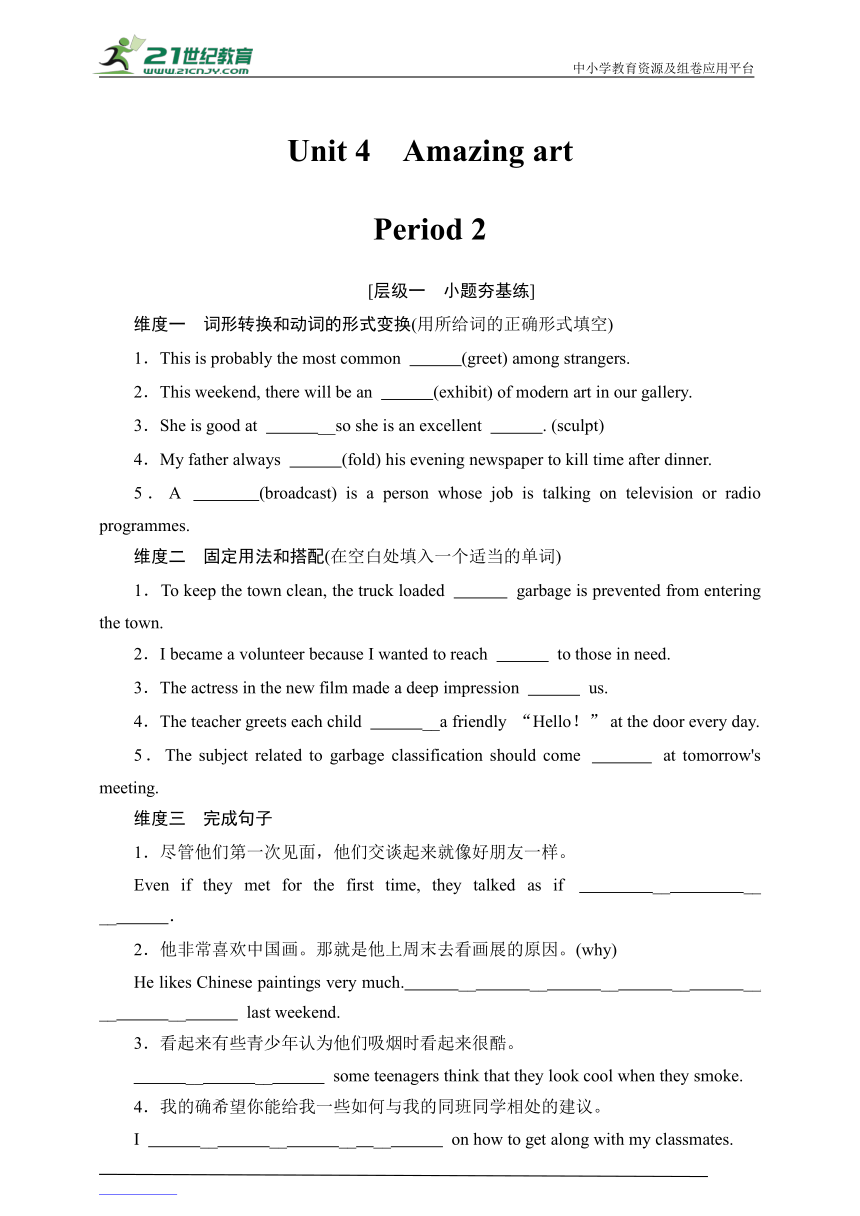 | |
| 格式 | doc | ||
| 文件大小 | 3.1MB | ||
| 资源类型 | 试卷 | ||
| 版本资源 | 外研版(2019) | ||
| 科目 | 英语 | ||
| 更新时间 | 2022-12-06 14:37:49 | ||
图片预览

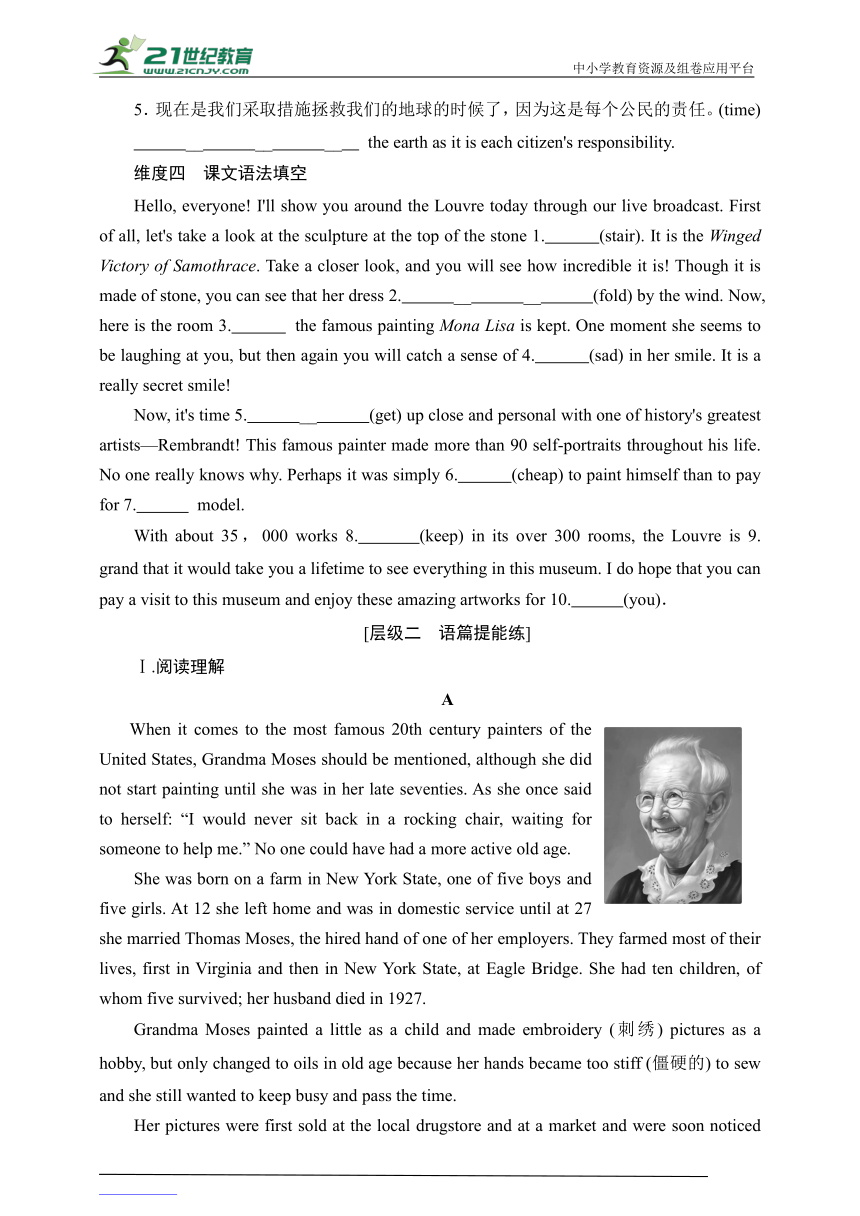
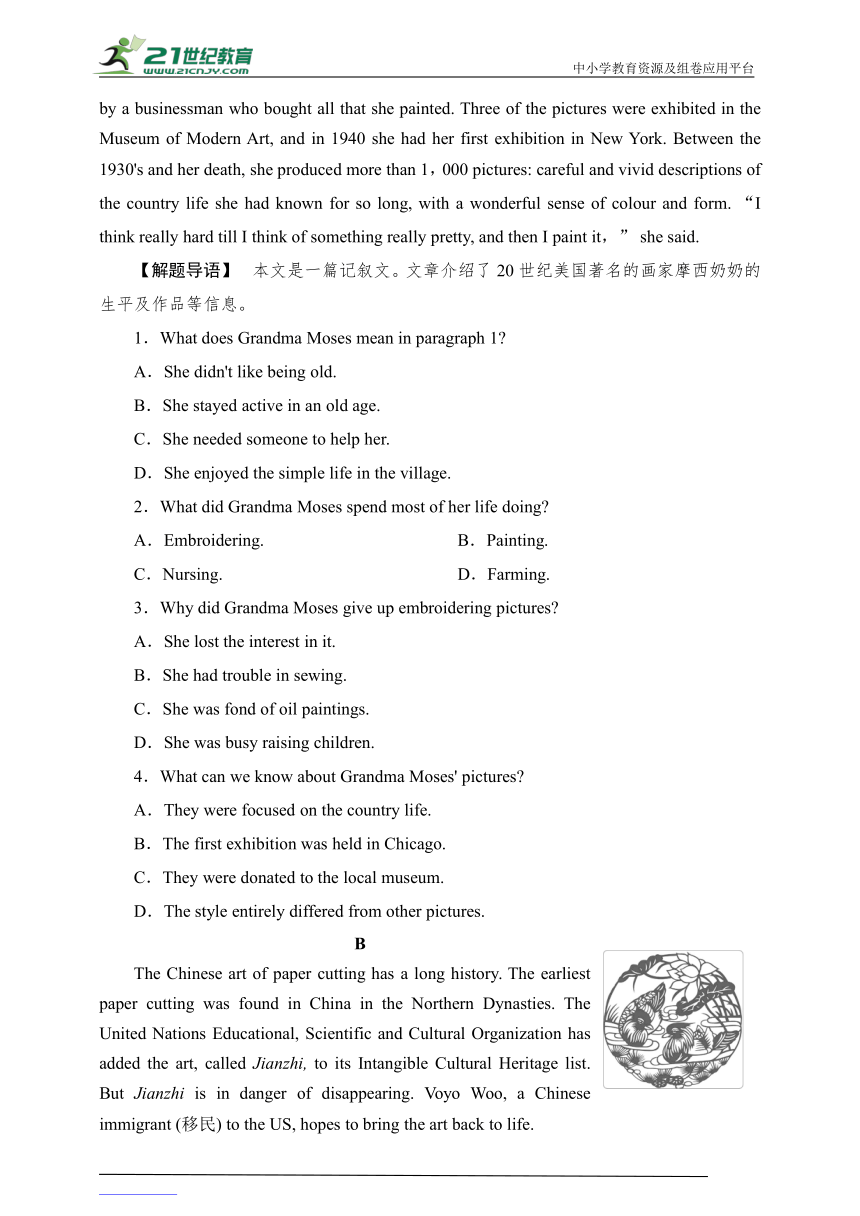
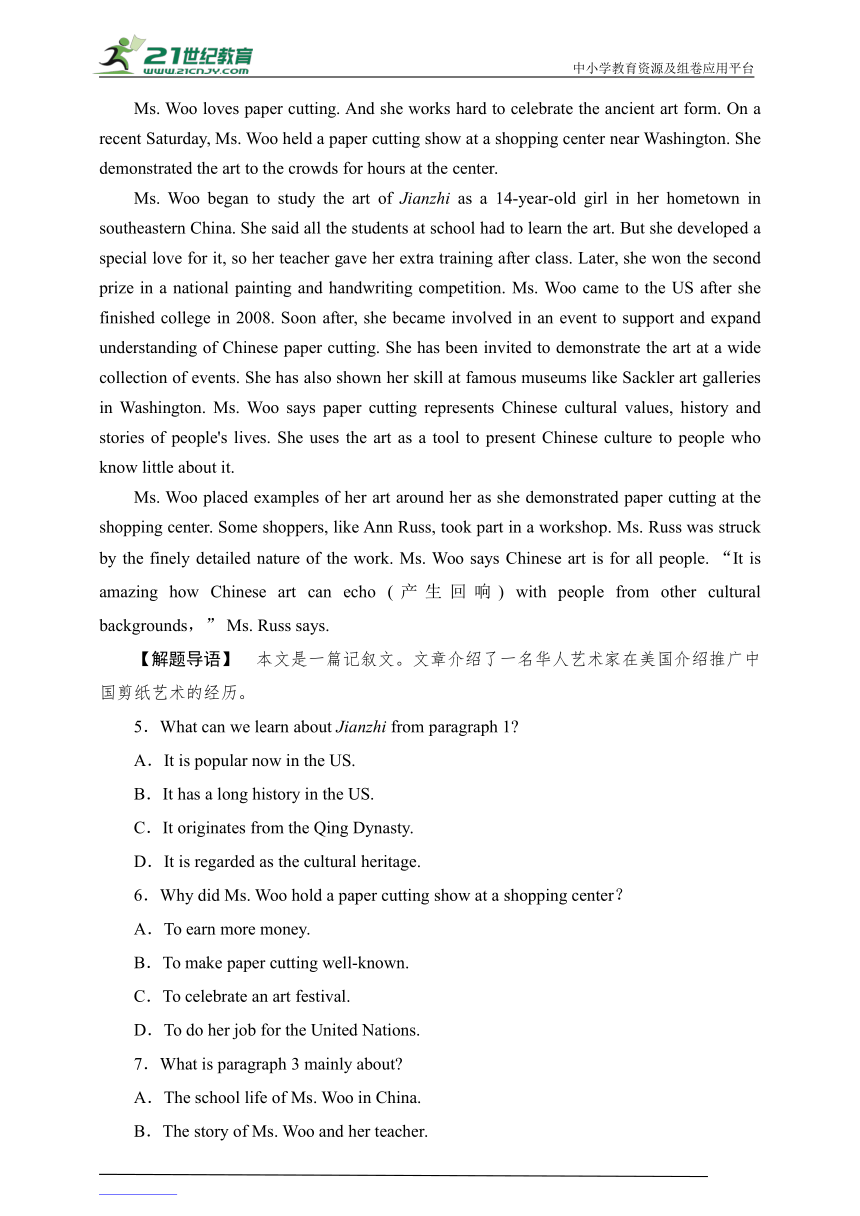
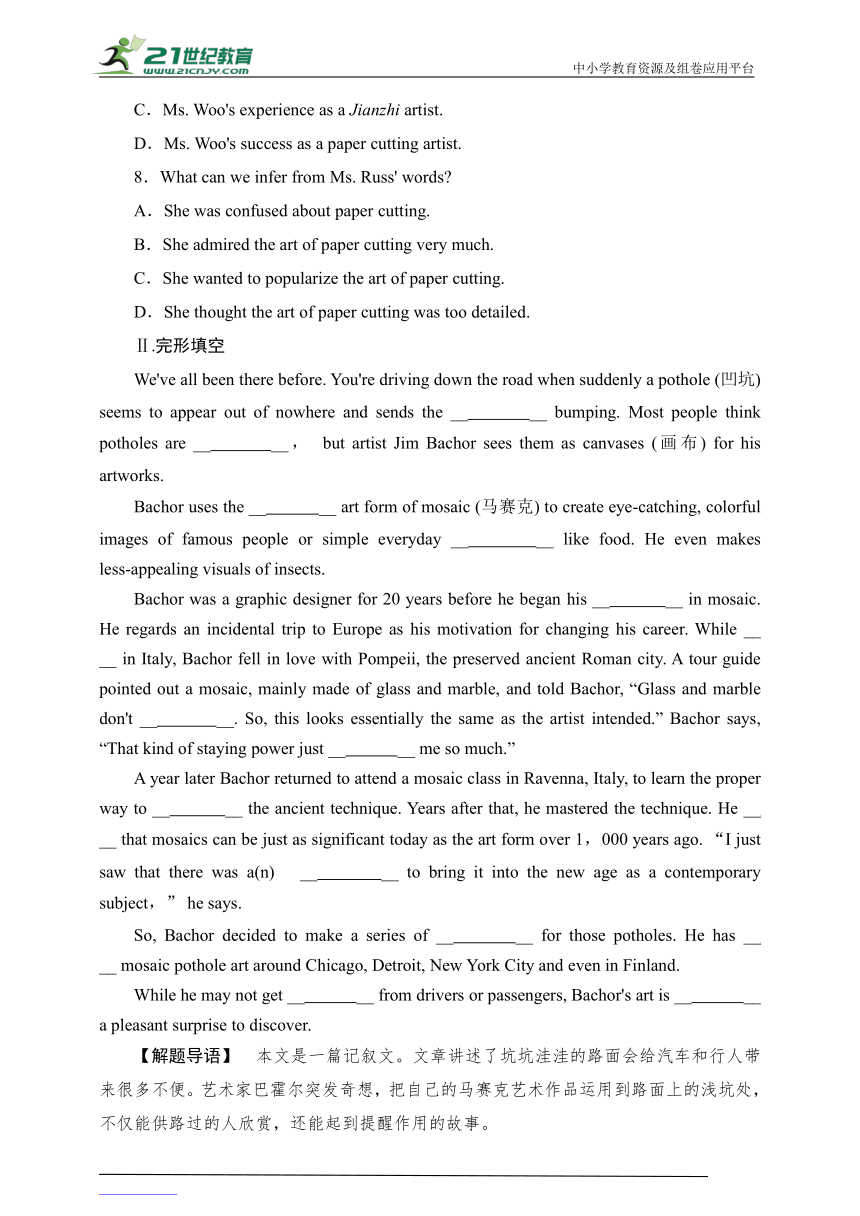
文档简介
中小学教育资源及组卷应用平台
Unit 4 Amazing art
Period 2
[层级一 小题夯基练]
维度一 词形转换和动词的形式变换(用所给词的正确形式填空)
1.This is probably the most common (greet) among strangers.
2.This weekend, there will be an (exhibit) of modern art in our gallery.
3.She is good at __so she is an excellent . (sculpt)
4.My father always (fold) his evening newspaper to kill time after dinner.
5.A (broadcast) is a person whose job is talking on television or radio programmes.
维度二 固定用法和搭配(在空白处填入一个适当的单词)
1.To keep the town clean, the truck loaded garbage is prevented from entering the town.
2.I became a volunteer because I wanted to reach to those in need.
3.The actress in the new film made a deep impression us.
4.The teacher greets each child __a friendly “Hello!” at the door every day.
5.The subject related to garbage classification should come at tomorrow's meeting.
维度三 完成句子
1.尽管他们第一次见面,他们交谈起来就像好朋友一样。
Even if they met for the first time, they talked as if __ __ __ .
2.他非常喜欢中国画。那就是他上周末去看画展的原因。(why)
He likes Chinese paintings very much. __ __ __ __ __ __ __ last weekend.
3.看起来有些青少年认为他们吸烟时看起来很酷。
__ __ some teenagers think that they look cool when they smoke.
4.我的确希望你能给我一些如何与我的同班同学相处的建议。
I __ __ __ __ on how to get along with my classmates.
5.现在是我们采取措施拯救我们的地球的时候了,因为这是每个公民的责任。(time)
__ __ __ the earth as it is each citizen's responsibility.
维度四 课文语法填空
Hello, everyone! I'll show you around the Louvre today through our live broadcast. First of all, let's take a look at the sculpture at the top of the stone 1. (stair). It is the Winged Victory of Samothrace. Take a closer look, and you will see how incredible it is! Though it is made of stone, you can see that her dress 2. __ __ (fold) by the wind. Now, here is the room 3. the famous painting Mona Lisa is kept. One moment she seems to be laughing at you, but then again you will catch a sense of 4. (sad) in her smile. It is a really secret smile!
Now, it's time 5. __ (get) up close and personal with one of history's greatest artists—Rembrandt! This famous painter made more than 90 self portraits throughout his life. No one really knows why. Perhaps it was simply 6. (cheap) to paint himself than to pay for 7. model.
With about 35,000 works 8. (keep) in its over 300 rooms, the Louvre is 9. grand that it would take you a lifetime to see everything in this museum. I do hope that you can pay a visit to this museum and enjoy these amazing artworks for 10. (you).
[层级二 语篇提能练]
Ⅰ.阅读理解
A
When it comes to the most famous 20th century painters of the United States, Grandma Moses should be mentioned, although she did not start painting until she was in her late seventies. As she once said to herself: “I would never sit back in a rocking chair, waiting for someone to help me.” No one could have had a more active old age.
She was born on a farm in New York State, one of five boys and five girls. At 12 she left home and was in domestic service until at 27 she married Thomas Moses, the hired hand of one of her employers. They farmed most of their lives, first in Virginia and then in New York State, at Eagle Bridge. She had ten children, of whom five survived; her husband died in 1927.
Grandma Moses painted a little as a child and made embroidery (刺绣) pictures as a hobby, but only changed to oils in old age because her hands became too stiff (僵硬的) to sew and she still wanted to keep busy and pass the time.
Her pictures were first sold at the local drugstore and at a market and were soon noticed by a businessman who bought all that she painted. Three of the pictures were exhibited in the Museum of Modern Art, and in 1940 she had her first exhibition in New York. Between the 1930's and her death, she produced more than 1,000 pictures: careful and vivid descriptions of the country life she had known for so long, with a wonderful sense of colour and form. “I think really hard till I think of something really pretty, and then I paint it,” she said.
【解题导语】 本文是一篇记叙文。文章介绍了20世纪美国著名的画家摩西奶奶的生平及作品等信息。
1.What does Grandma Moses mean in paragraph 1
A.She didn't like being old.
B.She stayed active in an old age.
C.She needed someone to help her.
D.She enjoyed the simple life in the village.
2.What did Grandma Moses spend most of her life doing
A.Embroidering. B.Painting.
C.Nursing. D.Farming.
3.Why did Grandma Moses give up embroidering pictures
A.She lost the interest in it.
B.She had trouble in sewing.
C.She was fond of oil paintings.
D.She was busy raising children.
4.What can we know about Grandma Moses' pictures
A.They were focused on the country life.
B.The first exhibition was held in Chicago.
C.They were donated to the local museum.
D.The style entirely differed from other pictures.
B
The Chinese art of paper cutting has a long history. The earliest paper cutting was found in China in the Northern Dynasties. The United Nations Educational, Scientific and Cultural Organization has added the art, called Jianzhi, to its Intangible Cultural Heritage list. But Jianzhi is in danger of disappearing. Voyo Woo, a Chinese immigrant (移民) to the US, hopes to bring the art back to life.
Ms. Woo loves paper cutting. And she works hard to celebrate the ancient art form. On a recent Saturday, Ms. Woo held a paper cutting show at a shopping center near Washington. She demonstrated the art to the crowds for hours at the center.
Ms. Woo began to study the art of Jianzhi as a 14 year old girl in her hometown in southeastern China. She said all the students at school had to learn the art. But she developed a special love for it, so her teacher gave her extra training after class. Later, she won the second prize in a national painting and handwriting competition. Ms. Woo came to the US after she finished college in 2008. Soon after, she became involved in an event to support and expand understanding of Chinese paper cutting. She has been invited to demonstrate the art at a wide collection of events. She has also shown her skill at famous museums like Sackler art galleries in Washington. Ms. Woo says paper cutting represents Chinese cultural values, history and stories of people's lives. She uses the art as a tool to present Chinese culture to people who know little about it.
Ms. Woo placed examples of her art around her as she demonstrated paper cutting at the shopping center. Some shoppers, like Ann Russ, took part in a workshop. Ms. Russ was struck by the finely detailed nature of the work. Ms. Woo says Chinese art is for all people. “It is amazing how Chinese art can echo (产生回响) with people from other cultural backgrounds,” Ms. Russ says.
【解题导语】 本文是一篇记叙文。文章介绍了一名华人艺术家在美国介绍推广中国剪纸艺术的经历。
5.What can we learn about Jianzhi from paragraph 1
A.It is popular now in the US.
B.It has a long history in the US.
C.It originates from the Qing Dynasty.
D.It is regarded as the cultural heritage.
6.Why did Ms. Woo hold a paper cutting show at a shopping center?
A.To earn more money.
B.To make paper cutting well known.
C.To celebrate an art festival.
D.To do her job for the United Nations.
7.What is paragraph 3 mainly about
A.The school life of Ms. Woo in China.
B.The story of Ms. Woo and her teacher.
C.Ms. Woo's experience as a Jianzhi artist.
D.Ms. Woo's success as a paper cutting artist.
8.What can we infer from Ms. Russ' words
A.She was confused about paper cutting.
B.She admired the art of paper cutting very much.
C.She wanted to popularize the art of paper cutting.
D.She thought the art of paper cutting was too detailed.
Ⅱ.完形填空
We've all been there before. You're driving down the road when suddenly a pothole (凹坑) seems to appear out of nowhere and sends the __ __ bumping. Most people think potholes are __ __, but artist Jim Bachor sees them as canvases (画布) for his artworks.
Bachor uses the __ __ art form of mosaic (马赛克) to create eye catching, colorful images of famous people or simple everyday __ __ like food. He even makes less appealing visuals of insects.
Bachor was a graphic designer for 20 years before he began his __ __ in mosaic. He regards an incidental trip to Europe as his motivation for changing his career. While __ __ in Italy, Bachor fell in love with Pompeii, the preserved ancient Roman city. A tour guide pointed out a mosaic, mainly made of glass and marble, and told Bachor, “Glass and marble don't __ __. So, this looks essentially the same as the artist intended.” Bachor says, “That kind of staying power just __ __ me so much.”
A year later Bachor returned to attend a mosaic class in Ravenna, Italy, to learn the proper way to __ __ the ancient technique. Years after that, he mastered the technique. He __ __ that mosaics can be just as significant today as the art form over 1,000 years ago. “I just saw that there was a(n) __ __ to bring it into the new age as a contemporary subject,” he says.
So, Bachor decided to make a series of __ __ for those potholes. He has __ __ mosaic pothole art around Chicago, Detroit, New York City and even in Finland.
While he may not get __ __ from drivers or passengers, Bachor's art is __ __ a pleasant surprise to discover.
【解题导语】 本文是一篇记叙文。文章讲述了坑坑洼洼的路面会给汽车和行人带来很多不便。艺术家巴霍尔突发奇想,把自己的马赛克艺术作品运用到路面上的浅坑处,不仅能供路过的人欣赏,还能起到提醒作用的故事。
1.A.body B.rock
C.car D.sand
2.A.challenging B.interesting
C.discouraging D.annoying
3.A.modern B.ancient
C.elegant D.mysterious
4.A.objects B.ideas
C.routines D.projects
5.A.duty B.career
C.belief D.instruction
6.A.traveling B.living
C.working D.studying
7.A.last B.connect
C.fade D.break
8.A.reminded B.confused
C.troubled D.impressed
9.A.introduce B.apply
C.promote D.describe
10.A.argued B.imagined
C.remembered D.realized
11.A.link B.time
C.opportunity D.voice
12.A.artworks B.poetry
C.music D.videos
13.A.discovered B.created
C.improved D.taught
14.A.help B.invitation
C.money D.praise
15.A.nearly B.merely
C.certainly D.personally
参考答案
[层级一 小题夯基练]
维度一 词形转换和动词的形式变换(用所给词的正确形式填空)
1. greeting.
2. exhibition.
3.Sculpting sculptor.
4. unfolds.
5.broadcaster
维度二 固定用法和搭配(在空白处填入一个适当的单词)
1.with .
2. out .
3. on .
4. with__.
5. up .
维度三 完成句子
1.they__were__good__friends.
2.That's__why__he__went__to__the__art__exhibition last weekend.
3.It__seems__that
4.do__hope__you__can__give__me__some__tips
5.It's__time__for__us__to__take__measures__to__save
维度四 课文语法填空
1.stairs
2.is__being__folded
3.where
4.sadness
5.to__get
6.cheaper
7.a
8.kept
9.so
10.yourselves
[层级二 语篇提能练]
Ⅰ.阅读理解
A
1.
B 解析:推理判断题。根据第一段中的“she did not start painting until she was in her late seventies”“I would never sit back in a rocking chair, waiting for someone to help me.”和“No one could have had a more active old age.”可知,摩西奶奶快80岁时才开始画画。由此可推知,她在老年时仍十分活跃。故选B。
2.
D 解析:细节理解题。根据第二段中的“They farmed most of their lives, first in Virginia and then in New York State, at Eagle Bridge.”可知,摩西奶奶和她的丈夫在一生中的大部分时间都在务农。故选D。
3.
B 解析:细节理解题。根据第三段中的“Grandma Moses painted a little as a child and made embroidery pictures as a hobby, but only changed to oils in old age because her hands became too stiff to sew”可知,摩西奶奶由于手掌僵硬无法做刺绣,于是转而画油画。故选B。
4.
A 解析:推理判断题。根据最后一段中的“she produced more than 1,000 pictures: careful and vivid descriptions of the country life she had known for so long”可知,摩西奶奶的画生动地描述了她所熟知的乡村生活。由此可推知,摩西奶奶的画关注乡村生活。故选A。
B
5.
D 解析:细节理解题。根据第一段中的“The United Nations Educational, Scientific and Cultural Organization has added the art, called Jianzhi, to its Intangible Cultural Heritage list.”可知,剪纸被列入非物质文化遗产名单。故选D。
6.
B 解析:推理判断题。根据第二段内容可知,吴女士在华盛顿的一个购物中心举办剪纸展是为了推广剪纸艺术。故选B。
7.
C 解析:段落大意题。根据第三段内容可知,本段讲述了吴女士是如何开始学习剪纸技艺的,以及后来获奖并到美国传播剪纸艺术的经历。故选C。
8.
B 解析:推理判断题。根据最后一段中的“Ms. Russ was struck by the finely detailed nature of the work. Ms. Woo says Chinese art is for all people. ‘It is amazing how Chinese art can echo with people from other cultural backgrounds’”可推知,她非常欣赏剪纸艺术。故选B。
Ⅱ.完形填空
1.
C 解析:根据“You're driving down the road”可知,此处讲你正开车沿着路行驶时,突然一个凹坑出现,让汽车(car)颠簸。
2.
D 解析:根据常识可知,大多数人认为凹坑很烦人(annoying),但艺术家巴霍尔把它们看作是他的艺术作品的画布。
3.
B 解析:根据语境可知,此处指巴霍尔利用古老的(ancient)马赛克艺术形式创造了许多引人注目、丰富多彩的形象。下文中的the ancient technique亦是提示。
4.
A 解析:根据like food和everyday可推断,此处指简单的日常物品(objects)。
5.
B 解析:根据下文中的“He regards an incidental trip to Europe as his motivation for changing his career.”可知,此处指的是他的事业(career)。
6.
A 解析:根据下文中提到的A tour guide可知,此处指巴霍尔在意大利旅行(traveling)期间。
7.
C 解析:根据下文中的“So, this looks essentially the same as the artist intended.”可知,玻璃和大理石不会褪色(fade),所以作品从本质上看起来还是艺术家的本意。
8.
D 解析:根据语境并结合选项可知,这种持久力让巴霍尔印象(impressed)深刻。
9.
B 解析:根据下文中的“Years after that, he mastered the technique.”可推断,巴霍尔参加课程学习如何应用(apply)这种古代技术。
10.
D 解析:根据下文中的“to bring it into the new age as a contemporary subject”可知,此处指巴霍尔意识到(realized)在今天马赛克工艺也是重要的。
11.
C 解析:根据下文中的“So, Bachor decided to make a series of ______ for those potholes.”可知,巴霍尔看到了一个把它作为当代题材带入新时代的机会(opportunity)。
12.
A 解析:根据语境可知,此处指巴霍尔决定为那些凹坑制作一系列艺术作品(artworks)。
13.
B 解析:根据语境可知,此处指他在芝加哥、底特律、纽约市甚至芬兰都创作了(created)马赛克工艺坑洞艺术品。
14.
D 解析:根据下文a pleasant surprise可推知,尽管巴霍尔或许得不到来自司机和乘客的表扬(praise),但巴霍尔的艺术无疑(certainly)是一个令人惊喜的发现。
15.
C 解析:参见上题解析。
21世纪教育网 www.21cnjy.com 精品试卷·第 2 页 (共 2 页)
Unit 4 Amazing art
Period 2
[层级一 小题夯基练]
维度一 词形转换和动词的形式变换(用所给词的正确形式填空)
1.This is probably the most common (greet) among strangers.
2.This weekend, there will be an (exhibit) of modern art in our gallery.
3.She is good at __so she is an excellent . (sculpt)
4.My father always (fold) his evening newspaper to kill time after dinner.
5.A (broadcast) is a person whose job is talking on television or radio programmes.
维度二 固定用法和搭配(在空白处填入一个适当的单词)
1.To keep the town clean, the truck loaded garbage is prevented from entering the town.
2.I became a volunteer because I wanted to reach to those in need.
3.The actress in the new film made a deep impression us.
4.The teacher greets each child __a friendly “Hello!” at the door every day.
5.The subject related to garbage classification should come at tomorrow's meeting.
维度三 完成句子
1.尽管他们第一次见面,他们交谈起来就像好朋友一样。
Even if they met for the first time, they talked as if __ __ __ .
2.他非常喜欢中国画。那就是他上周末去看画展的原因。(why)
He likes Chinese paintings very much. __ __ __ __ __ __ __ last weekend.
3.看起来有些青少年认为他们吸烟时看起来很酷。
__ __ some teenagers think that they look cool when they smoke.
4.我的确希望你能给我一些如何与我的同班同学相处的建议。
I __ __ __ __ on how to get along with my classmates.
5.现在是我们采取措施拯救我们的地球的时候了,因为这是每个公民的责任。(time)
__ __ __ the earth as it is each citizen's responsibility.
维度四 课文语法填空
Hello, everyone! I'll show you around the Louvre today through our live broadcast. First of all, let's take a look at the sculpture at the top of the stone 1. (stair). It is the Winged Victory of Samothrace. Take a closer look, and you will see how incredible it is! Though it is made of stone, you can see that her dress 2. __ __ (fold) by the wind. Now, here is the room 3. the famous painting Mona Lisa is kept. One moment she seems to be laughing at you, but then again you will catch a sense of 4. (sad) in her smile. It is a really secret smile!
Now, it's time 5. __ (get) up close and personal with one of history's greatest artists—Rembrandt! This famous painter made more than 90 self portraits throughout his life. No one really knows why. Perhaps it was simply 6. (cheap) to paint himself than to pay for 7. model.
With about 35,000 works 8. (keep) in its over 300 rooms, the Louvre is 9. grand that it would take you a lifetime to see everything in this museum. I do hope that you can pay a visit to this museum and enjoy these amazing artworks for 10. (you).
[层级二 语篇提能练]
Ⅰ.阅读理解
A
When it comes to the most famous 20th century painters of the United States, Grandma Moses should be mentioned, although she did not start painting until she was in her late seventies. As she once said to herself: “I would never sit back in a rocking chair, waiting for someone to help me.” No one could have had a more active old age.
She was born on a farm in New York State, one of five boys and five girls. At 12 she left home and was in domestic service until at 27 she married Thomas Moses, the hired hand of one of her employers. They farmed most of their lives, first in Virginia and then in New York State, at Eagle Bridge. She had ten children, of whom five survived; her husband died in 1927.
Grandma Moses painted a little as a child and made embroidery (刺绣) pictures as a hobby, but only changed to oils in old age because her hands became too stiff (僵硬的) to sew and she still wanted to keep busy and pass the time.
Her pictures were first sold at the local drugstore and at a market and were soon noticed by a businessman who bought all that she painted. Three of the pictures were exhibited in the Museum of Modern Art, and in 1940 she had her first exhibition in New York. Between the 1930's and her death, she produced more than 1,000 pictures: careful and vivid descriptions of the country life she had known for so long, with a wonderful sense of colour and form. “I think really hard till I think of something really pretty, and then I paint it,” she said.
【解题导语】 本文是一篇记叙文。文章介绍了20世纪美国著名的画家摩西奶奶的生平及作品等信息。
1.What does Grandma Moses mean in paragraph 1
A.She didn't like being old.
B.She stayed active in an old age.
C.She needed someone to help her.
D.She enjoyed the simple life in the village.
2.What did Grandma Moses spend most of her life doing
A.Embroidering. B.Painting.
C.Nursing. D.Farming.
3.Why did Grandma Moses give up embroidering pictures
A.She lost the interest in it.
B.She had trouble in sewing.
C.She was fond of oil paintings.
D.She was busy raising children.
4.What can we know about Grandma Moses' pictures
A.They were focused on the country life.
B.The first exhibition was held in Chicago.
C.They were donated to the local museum.
D.The style entirely differed from other pictures.
B
The Chinese art of paper cutting has a long history. The earliest paper cutting was found in China in the Northern Dynasties. The United Nations Educational, Scientific and Cultural Organization has added the art, called Jianzhi, to its Intangible Cultural Heritage list. But Jianzhi is in danger of disappearing. Voyo Woo, a Chinese immigrant (移民) to the US, hopes to bring the art back to life.
Ms. Woo loves paper cutting. And she works hard to celebrate the ancient art form. On a recent Saturday, Ms. Woo held a paper cutting show at a shopping center near Washington. She demonstrated the art to the crowds for hours at the center.
Ms. Woo began to study the art of Jianzhi as a 14 year old girl in her hometown in southeastern China. She said all the students at school had to learn the art. But she developed a special love for it, so her teacher gave her extra training after class. Later, she won the second prize in a national painting and handwriting competition. Ms. Woo came to the US after she finished college in 2008. Soon after, she became involved in an event to support and expand understanding of Chinese paper cutting. She has been invited to demonstrate the art at a wide collection of events. She has also shown her skill at famous museums like Sackler art galleries in Washington. Ms. Woo says paper cutting represents Chinese cultural values, history and stories of people's lives. She uses the art as a tool to present Chinese culture to people who know little about it.
Ms. Woo placed examples of her art around her as she demonstrated paper cutting at the shopping center. Some shoppers, like Ann Russ, took part in a workshop. Ms. Russ was struck by the finely detailed nature of the work. Ms. Woo says Chinese art is for all people. “It is amazing how Chinese art can echo (产生回响) with people from other cultural backgrounds,” Ms. Russ says.
【解题导语】 本文是一篇记叙文。文章介绍了一名华人艺术家在美国介绍推广中国剪纸艺术的经历。
5.What can we learn about Jianzhi from paragraph 1
A.It is popular now in the US.
B.It has a long history in the US.
C.It originates from the Qing Dynasty.
D.It is regarded as the cultural heritage.
6.Why did Ms. Woo hold a paper cutting show at a shopping center?
A.To earn more money.
B.To make paper cutting well known.
C.To celebrate an art festival.
D.To do her job for the United Nations.
7.What is paragraph 3 mainly about
A.The school life of Ms. Woo in China.
B.The story of Ms. Woo and her teacher.
C.Ms. Woo's experience as a Jianzhi artist.
D.Ms. Woo's success as a paper cutting artist.
8.What can we infer from Ms. Russ' words
A.She was confused about paper cutting.
B.She admired the art of paper cutting very much.
C.She wanted to popularize the art of paper cutting.
D.She thought the art of paper cutting was too detailed.
Ⅱ.完形填空
We've all been there before. You're driving down the road when suddenly a pothole (凹坑) seems to appear out of nowhere and sends the __ __ bumping. Most people think potholes are __ __, but artist Jim Bachor sees them as canvases (画布) for his artworks.
Bachor uses the __ __ art form of mosaic (马赛克) to create eye catching, colorful images of famous people or simple everyday __ __ like food. He even makes less appealing visuals of insects.
Bachor was a graphic designer for 20 years before he began his __ __ in mosaic. He regards an incidental trip to Europe as his motivation for changing his career. While __ __ in Italy, Bachor fell in love with Pompeii, the preserved ancient Roman city. A tour guide pointed out a mosaic, mainly made of glass and marble, and told Bachor, “Glass and marble don't __ __. So, this looks essentially the same as the artist intended.” Bachor says, “That kind of staying power just __ __ me so much.”
A year later Bachor returned to attend a mosaic class in Ravenna, Italy, to learn the proper way to __ __ the ancient technique. Years after that, he mastered the technique. He __ __ that mosaics can be just as significant today as the art form over 1,000 years ago. “I just saw that there was a(n) __ __ to bring it into the new age as a contemporary subject,” he says.
So, Bachor decided to make a series of __ __ for those potholes. He has __ __ mosaic pothole art around Chicago, Detroit, New York City and even in Finland.
While he may not get __ __ from drivers or passengers, Bachor's art is __ __ a pleasant surprise to discover.
【解题导语】 本文是一篇记叙文。文章讲述了坑坑洼洼的路面会给汽车和行人带来很多不便。艺术家巴霍尔突发奇想,把自己的马赛克艺术作品运用到路面上的浅坑处,不仅能供路过的人欣赏,还能起到提醒作用的故事。
1.A.body B.rock
C.car D.sand
2.A.challenging B.interesting
C.discouraging D.annoying
3.A.modern B.ancient
C.elegant D.mysterious
4.A.objects B.ideas
C.routines D.projects
5.A.duty B.career
C.belief D.instruction
6.A.traveling B.living
C.working D.studying
7.A.last B.connect
C.fade D.break
8.A.reminded B.confused
C.troubled D.impressed
9.A.introduce B.apply
C.promote D.describe
10.A.argued B.imagined
C.remembered D.realized
11.A.link B.time
C.opportunity D.voice
12.A.artworks B.poetry
C.music D.videos
13.A.discovered B.created
C.improved D.taught
14.A.help B.invitation
C.money D.praise
15.A.nearly B.merely
C.certainly D.personally
参考答案
[层级一 小题夯基练]
维度一 词形转换和动词的形式变换(用所给词的正确形式填空)
1. greeting.
2. exhibition.
3.Sculpting sculptor.
4. unfolds.
5.broadcaster
维度二 固定用法和搭配(在空白处填入一个适当的单词)
1.with .
2. out .
3. on .
4. with__.
5. up .
维度三 完成句子
1.they__were__good__friends.
2.That's__why__he__went__to__the__art__exhibition last weekend.
3.It__seems__that
4.do__hope__you__can__give__me__some__tips
5.It's__time__for__us__to__take__measures__to__save
维度四 课文语法填空
1.stairs
2.is__being__folded
3.where
4.sadness
5.to__get
6.cheaper
7.a
8.kept
9.so
10.yourselves
[层级二 语篇提能练]
Ⅰ.阅读理解
A
1.
B 解析:推理判断题。根据第一段中的“she did not start painting until she was in her late seventies”“I would never sit back in a rocking chair, waiting for someone to help me.”和“No one could have had a more active old age.”可知,摩西奶奶快80岁时才开始画画。由此可推知,她在老年时仍十分活跃。故选B。
2.
D 解析:细节理解题。根据第二段中的“They farmed most of their lives, first in Virginia and then in New York State, at Eagle Bridge.”可知,摩西奶奶和她的丈夫在一生中的大部分时间都在务农。故选D。
3.
B 解析:细节理解题。根据第三段中的“Grandma Moses painted a little as a child and made embroidery pictures as a hobby, but only changed to oils in old age because her hands became too stiff to sew”可知,摩西奶奶由于手掌僵硬无法做刺绣,于是转而画油画。故选B。
4.
A 解析:推理判断题。根据最后一段中的“she produced more than 1,000 pictures: careful and vivid descriptions of the country life she had known for so long”可知,摩西奶奶的画生动地描述了她所熟知的乡村生活。由此可推知,摩西奶奶的画关注乡村生活。故选A。
B
5.
D 解析:细节理解题。根据第一段中的“The United Nations Educational, Scientific and Cultural Organization has added the art, called Jianzhi, to its Intangible Cultural Heritage list.”可知,剪纸被列入非物质文化遗产名单。故选D。
6.
B 解析:推理判断题。根据第二段内容可知,吴女士在华盛顿的一个购物中心举办剪纸展是为了推广剪纸艺术。故选B。
7.
C 解析:段落大意题。根据第三段内容可知,本段讲述了吴女士是如何开始学习剪纸技艺的,以及后来获奖并到美国传播剪纸艺术的经历。故选C。
8.
B 解析:推理判断题。根据最后一段中的“Ms. Russ was struck by the finely detailed nature of the work. Ms. Woo says Chinese art is for all people. ‘It is amazing how Chinese art can echo with people from other cultural backgrounds’”可推知,她非常欣赏剪纸艺术。故选B。
Ⅱ.完形填空
1.
C 解析:根据“You're driving down the road”可知,此处讲你正开车沿着路行驶时,突然一个凹坑出现,让汽车(car)颠簸。
2.
D 解析:根据常识可知,大多数人认为凹坑很烦人(annoying),但艺术家巴霍尔把它们看作是他的艺术作品的画布。
3.
B 解析:根据语境可知,此处指巴霍尔利用古老的(ancient)马赛克艺术形式创造了许多引人注目、丰富多彩的形象。下文中的the ancient technique亦是提示。
4.
A 解析:根据like food和everyday可推断,此处指简单的日常物品(objects)。
5.
B 解析:根据下文中的“He regards an incidental trip to Europe as his motivation for changing his career.”可知,此处指的是他的事业(career)。
6.
A 解析:根据下文中提到的A tour guide可知,此处指巴霍尔在意大利旅行(traveling)期间。
7.
C 解析:根据下文中的“So, this looks essentially the same as the artist intended.”可知,玻璃和大理石不会褪色(fade),所以作品从本质上看起来还是艺术家的本意。
8.
D 解析:根据语境并结合选项可知,这种持久力让巴霍尔印象(impressed)深刻。
9.
B 解析:根据下文中的“Years after that, he mastered the technique.”可推断,巴霍尔参加课程学习如何应用(apply)这种古代技术。
10.
D 解析:根据下文中的“to bring it into the new age as a contemporary subject”可知,此处指巴霍尔意识到(realized)在今天马赛克工艺也是重要的。
11.
C 解析:根据下文中的“So, Bachor decided to make a series of ______ for those potholes.”可知,巴霍尔看到了一个把它作为当代题材带入新时代的机会(opportunity)。
12.
A 解析:根据语境可知,此处指巴霍尔决定为那些凹坑制作一系列艺术作品(artworks)。
13.
B 解析:根据语境可知,此处指他在芝加哥、底特律、纽约市甚至芬兰都创作了(created)马赛克工艺坑洞艺术品。
14.
D 解析:根据下文a pleasant surprise可推知,尽管巴霍尔或许得不到来自司机和乘客的表扬(praise),但巴霍尔的艺术无疑(certainly)是一个令人惊喜的发现。
15.
C 解析:参见上题解析。
21世纪教育网 www.21cnjy.com 精品试卷·第 2 页 (共 2 页)
